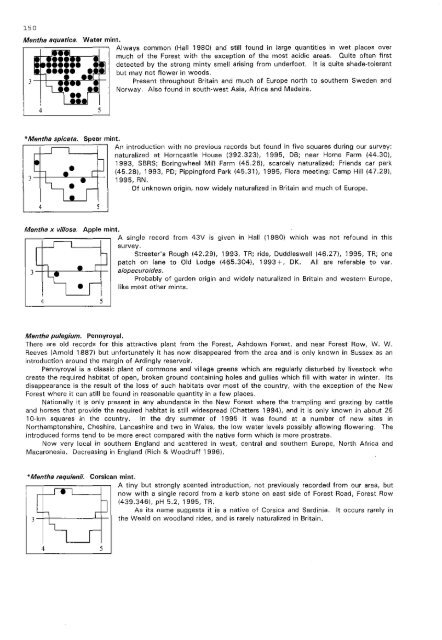Flora of Ashdown Forest - Botanical Society of the British Isles
Flora of Ashdown Forest - Botanical Society of the British Isles
Flora of Ashdown Forest - Botanical Society of the British Isles
Create successful ePaper yourself
Turn your PDF publications into a flip-book with our unique Google optimized e-Paper software.
150Mentha aquatica. Water mint.Always common (Hall 1980) and still found in large quantities in wet places overmuch <strong>of</strong> <strong>the</strong> <strong>Forest</strong> with <strong>the</strong> exception <strong>of</strong> <strong>the</strong> most acidic areas. Quite <strong>of</strong>ten firstdetected by <strong>the</strong> strong minty smell arising from underfoot. It is quite shade-tolerantbut may not flower in woods.Present throughout Britain and much <strong>of</strong> Europe north to sou<strong>the</strong>rn Sweden andNorway. Also found in south-west Asia, Africa and Madeira.* Mentha spicata. Spear mint.An introduction with no previous records but found in five squares during our survey:naturalized at Horncastle House (392.323), 1995, DB; near Home Farm (44.30),1993, SBRS; Boringwheel Mill Farm (45.26), scarcely naturalized; Friends car park(45.28), 1993, PD; Pippingford Park (45.31), 1995, <strong>Flora</strong> meeting; Camp Hill (47.29),3 1995, RN.Of unknown origin, now widely naturalized in Britain and much <strong>of</strong> Europe.4 5Mentha x vil/asa. Apple mint.A single record from 43V is given in Hall (1980) which was not refound in thissurvey.Streeter's Rough (42.29), 1993, TR; ride, Duddleswell (46.27), 1995, TR; onepatch on lane to Old Lodge (465.304), 1993 +, DK. All are referable to var.3 -f--h..-----"'---'-+_ a/opecuroides.Probably <strong>of</strong> garden origin and widely naturalized in Britain and western Europe,like most o<strong>the</strong>r mints.4 5Mentha pulegium. Pennyroyal.There are old records for this attractive plant from <strong>the</strong> <strong>Forest</strong>, <strong>Ashdown</strong> <strong>Forest</strong>, and near <strong>Forest</strong> Row, W. W.Reeves (Arnold 1887) but unfortunately it has now disappeared from <strong>the</strong> area and is only known in Sussex as anintroduction around <strong>the</strong> margin <strong>of</strong> Ardingly reservoir.Pennyroyal is a classic plant <strong>of</strong> commons and village greens which are regularly disturbed by livestock whocreate <strong>the</strong> required habitat <strong>of</strong> open, broken ground containing holes and gullies which fill with water in winter. Itsdisappearance is <strong>the</strong> result <strong>of</strong> <strong>the</strong> loss <strong>of</strong> such habitats over most <strong>of</strong> <strong>the</strong> country, with <strong>the</strong> exception <strong>of</strong> <strong>the</strong> New<strong>Forest</strong> where it can still be found in reasonable quantity in a few places.Nationally it is only present in any abundance in <strong>the</strong> New <strong>Forest</strong> where <strong>the</strong> trampling and grazing by cattleand horses that provide <strong>the</strong> required habitat is still widespread (Chatters 1994), and it is only known in about 251 O~km squares in <strong>the</strong> country. In <strong>the</strong> dry summer <strong>of</strong> 1995 it was found at a number <strong>of</strong> new sites inNorthamptonshire, Cheshire, Lancashire and two in Wales, <strong>the</strong> low water levels possibly allowing flowering. Theintroduced forms tend to be more erect compared with <strong>the</strong> native form which is more prostrate.Now very local in sou<strong>the</strong>rn England and scattered in west, central and sou<strong>the</strong>rn Europe, North Africa andMacaronesia. Decreasing in England (Rich & Woodruff 1996).*Mentha requienii. Corsican mint.A tiny but strongly scented introduction, not previously recorded from our area, butnow with a single record from a kerb stone on east side <strong>of</strong> <strong>Forest</strong> Road, <strong>Forest</strong> Row(439.346), pH 5.2, 1995, TR.As its name suggests it is a native <strong>of</strong> Corsica and Sardinia. It occurs rarely in3 <strong>the</strong> Weald on woodland rides, and is rarely naturalized in Britain.4 5
















